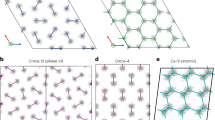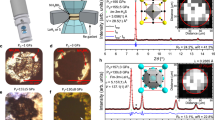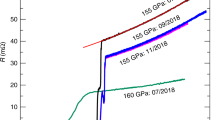Abstract
Although hydrogen is the simplest of atoms, it does not form the simplest of solids or liquids. Quantum effects in these phases are considerable (a consequence of the light proton mass) and they have a demonstrable and often puzzling influence on many physical properties1, including spatial order. To date, the structure of dense hydrogen remains experimentally elusive2. Recent studies of the melting curve of hydrogen3,4 indicate that at high (but experimentally accessible) pressures, compressed hydrogen will adopt a liquid state, even at low temperatures. In reaching this phase, hydrogen is also projected to pass through an insulator-to-metal transition. This raises the possibility of new state of matter: a near ground-state liquid metal, and its ordered states in the quantum domain. Ordered quantum fluids are traditionally categorized as superconductors or superfluids; these respective systems feature dissipationless electrical currents or mass flow. Here we report a topological analysis of the projected phase of liquid metallic hydrogen, finding that it may represent a new type of ordered quantum fluid. Specifically, we show that liquid metallic hydrogen cannot be categorized exclusively as a superconductor or superfluid. We predict that, in the presence of a magnetic field, liquid metallic hydrogen will exhibit several phase transitions to ordered states, ranging from superconductors to superfluids.
This is a preview of subscription content, access via your institution
Access options
Subscribe to this journal
Receive 51 print issues and online access
$199.00 per year
only $3.90 per issue
Buy this article
- Purchase on Springer Link
- Instant access to full article PDF
Prices may be subject to local taxes which are calculated during checkout


Similar content being viewed by others
References
Hemley, R. J. & Mao, H.-K. Dense molecular hydrogen; order, disorder and localization. J. Non.-Cryst. Solids 205, 282–289 (1996)
Ashcroft, N. W. The hydrogen liquids. J. Phys. A 12, A129–A137 (2000)
Datchi, F., Loubeyre, P. & LeToullec, R. Extended and accurate determination of the melting curves of argon, helium, ice (H2O), and hydrogen (H2). Phys. Rev. B 61, 6535–6546 (2000)
Bonev, S. A., Schwegler, E., Ogitsu, T. & Galli, G. A quantum fluid of metallic hydrogen. Nature (submitted)
Guillot, T. Probing the giant planets. Phys. Today 57, 63–69 (2004)
Stevenson, D. J., Ashcroft, N. W. Phys. Rev. A 9, 782–789 (1974)
Ashcroft, N. W. Hydrogen dominant metallic alloys: High temperature superconductors? Phys. Rev. Lett. 92, 187002 (2004)
Moulopolos, K. & Ashcroft, N. W. Generalized Coulomb pairing in condensed state. Phys. Rev. Lett. 66, 2915–2918 (1991)
Babaev, E., Faddeev, L. D. & Niemi, A. J. Hidden symmetry and duality in a charged two-condensate Bose system. Phys. Rev. B 65, 100512 (2002)
Babaev, E. Vortices with fractional flux in two-gap superconductors and in extended Faddeev model. Phys. Rev. Lett. 89, 067001 (2002)
Jaffe, J. & Ashcroft, N. W. Superconductivity in liquid metallic hydrogen. Phys. Rev. B 23, 6176–6179 (1981)
Jaffe, J. & Ashcroft, N. W. Critical fields of liquid superconducting metallic hydrogen. Phys. Rev. B 27, 5852–5855 (1983)
Fossheim, K. & Sudbø, A. Superconductivity: Physics and Applications Ch. 8 (Wiley & Sons, New York, 2004)
Smiseth, J., Smørgrav, E. & Sudbø, A. Critical properties of the N-color London model. Phys. Rev. Lett. 93, 077002 (2004)
Penrose, O. & Onsager, L. Bose-Einstein condensation and liquid helium. Phys. Rev. 104, 576–584 (1956)
Acknowledgements
This work was supported by the National Science Foundation, the Research Council of Norway, NANOMAT and by STINT and the Swedish Research Council.
Author information
Authors and Affiliations
Corresponding author
Ethics declarations
Competing interests
The authors declare that they have no competing financial interests.
Rights and permissions
About this article
Cite this article
Babaev, E., Sudbø, A. & Ashcroft, N. A superconductor to superfluid phase transition in liquid metallic hydrogen. Nature 431, 666–668 (2004). https://doi.org/10.1038/nature02910
Received:
Accepted:
Issue Date:
DOI: https://doi.org/10.1038/nature02910
This article is cited by
-
Calorimetric evidence for two phase transitions in Ba1−xKxFe2As2 with fermion pairing and quadrupling states
Nature Communications (2023)
-
Universal diamond edge Raman scale to 0.5 terapascal and implications for the metallization of hydrogen
Nature Communications (2023)
-
Magnetic detection under high pressures using designed silicon vacancy centres in silicon carbide
Nature Materials (2023)
-
State with spontaneously broken time-reversal symmetry above the superconducting phase transition
Nature Physics (2021)
-
Fractional Skyrmion molecules in a ℂPN−1 model
Journal of High Energy Physics (2021)
Comments
By submitting a comment you agree to abide by our Terms and Community Guidelines. If you find something abusive or that does not comply with our terms or guidelines please flag it as inappropriate.



